As young children, we learn to note the passing of time
by observing the sun's location in the sky or the lengthening
of shadows cast by the sun. Long ago, people discovered that
this observation may be used to create systems to accurately
measure time; the ancient Egyptians were the first people
that we know who made systematic efforts to keep time using
the sun. Though time is now defined in terms of a specific
atomic process, the heliochronometer, an instrument that
indicates time through the location of the sun's shadow,
was used to keep time in French train stations until as recently
as the early 1900s.
In this article, we'll consider some mathematical issues
involved in constructing a sundial. Today, sundials are usually
seen as decorative accents in gardens or more prominently
as public works of art. With care, however, it is straightforward
to create sundials that are accurate to within a minute.
We'll see that the process of constructing a dial involves
some simple applications of three-dimensional geometry that
help us translate the sun's motion across the sky into
an understanding of how a shadow will move across the sundial's
table.
The motion of the sun
In simplest terms, the task of constructing a sundial requires
us to relate the sun's position in the sky to the position
of a shadow it casts on some surface. Let's begin by
recalling the processes that regulate the sun's position
in the sky, focusing on the most important features and ignoring
some more subtle issues.
First, recall that the earth rotates on its axis once every
24 hours, which defines a day, and that the earth revolves
around the sun once a year, which defines a year.

Looking a little more closely, we see there is some interaction
between these two types of motion. Our usual notion of a
day is the solar day, the length of time between
when the sun appears at the same point in the sky, perhaps
due south of our location when viewing from the northern
hemisphere. This is the length of a day as measured by a
sundial. (In this image, the distance traveled by the earth
along its orbit in one day is exaggerated for the sake of
clarity.)

We should also consider the time required for a distant
star to appear at the same point in the sky from one day
to the next. Imagine that one day a star is directly behind
the sun. The next day, that star will appear slightly to
the west of the sun due to the motion of the earth along
its orbit. A sidereal day is the time required for
a star to appear in the same location in the sky, and it
will be shorter than a solar day.
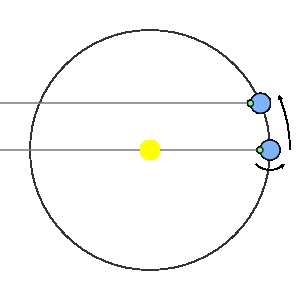
A tropical year is, informally, the length of
time required for the earth to return to the same point in
its orbit. Due to the earth's rotation, the number of
sidereal days in a tropical year will be one more than the
number of solar days. Since the length of a tropical year
is 365.2422 solar days, it is 366.2422 sidereal days; therefore,
the length of a sidereal day is 365.2422/366.2422 = 99.73%
the length of a solar day, which is a difference of a little
less than four minutes.
If our aim is to construct a sundial, sidereal time need
not concern us. However, there is a useful contrast to be
made. The length of the sidereal day depends only on the
rotation of the earth on its axis; it is therefore nearly
constant. A solar day, which depends on the speed of the
earth's rotation as well as its orbital velocity, is
not.
Two factors cause the length of a solar day to vary. First,
the earth's orbit is elliptical rather than circular,
and this causes the earth's orbital speed to vary. Second,
the earth's axis of rotation is not perpendicular to
the plane of its orbit, a fact well known for it is responsible
for creating the seasons. When viewed from earth, the sun
therefore does not move precisely in a circular path through
the sky, which causes some small variation in the length
of a solar day.
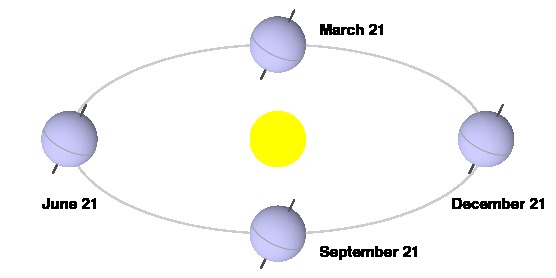
To smooth out these variations, we define a mean solar
day as the length of a solar day on an imaginary earth
moving at constant speed in a circular orbit with its rotational
axis perpendicular to the orbital plane. The length of
this day, roughly the average length of an actual solar
day, is constant throughout the year, and the time that
we read on our clocks is consequently defined by the mean
solar day.
It is therefore important to consider the difference between
mean time $T_m$, the time read on our clocks, and solar time
$T_s$, the time read on a sundial. We call this difference the
equation of time: $$ E = T_m - T_s \qquad \mbox{or}
\qquad T_m = T_s - E.$$
A graph of the equation of time, which may be determined
either through calculation or observation, looks like this:

If the equation of time is positive on a particular day,
then mean time lags behind solar time. On this day, the sun
will appear in the sky to the west of its location at the
same time on a day on which the equation is time is zero.
For the most part, our discussion will assume the days
have a constant length and then provide a correction using
the equation of time toward the end.
Coordinate Systems
To keep track of the position of the sun as well as our
position on the earth, we will introduce some coordinates.
Of course, it is well known that a position on the earth's
surface is often described by its latitude, the angular distance
from the equator, and its longitude, which is an angular
measure of the distance from the position to the line of
longitude through Greenwich.
 |
 |
| Latitude |
Longitude |
To describe the sun's position, we imagine the earth's
equator projected onto the celestial sphere, an arbitrarily
large sphere centered at the earth. Similar to the latitude
of a position on the earth's surface, the sun's declination
is the angular distance from its position to the celestial
equator. Since the earth's rotational axis is not perpendicular
to the plane of its orbit, the sun's declination varies
over a year.
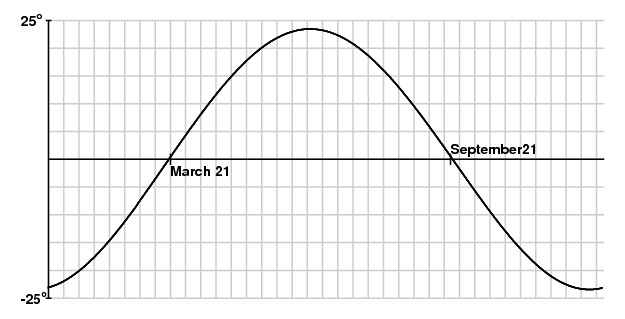
Meridians are lines on the celestial sphere given by projecting
lines of longitude onto that sphere. Solar time is determined
by the meridian on which the sun appears. Of particular importance
is the meridian corresponding to the line of longitude passing
through our location. We call this the noon meridian for
the sun should appear on this line at noon every day.
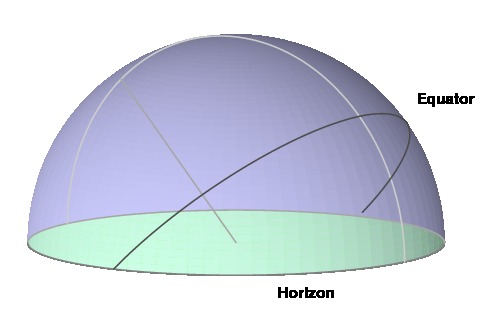
On a given day, the sun appears to move in an approximately
circular path about the earth; one such path, on a day in
early fall or late winter, is shown below. The sun will move
$360^\circ/24 = 15^\circ$ in an hour along this circular
path. This means it takes four minutes to move one degree.

It would be quite confusing if each of us defined noon
to be the time at which the sun passed through the noon meridian;
for instance, if you lived one degree east of me, your noon
would occur four minutes before mine. Instead, time zones
are established to provide a consistent time across a large
geographic region. I live in the Eastern time zone of the
United States, which is five hours behind universal time;
noon in this time zone is defined as the time at which the
sun passes the noon meridian at longitude $5 \cdot 15^\circ
= 75^\circ$ W. Time organized in this way is called legal
time.
Since I live at longitude $85.96^\circ$ W, noon Eastern
time will occur $(85.96-75)\cdot 4 = 43.84$ minutes before
passing through my noon meridian. Any sundial constructed
for this location will need to account for this difference.
Finally, many locations observe daylight savings time so
an hour may need to be added to the time read on the dial.
Orienting the style
Now let's get to work constructing a sundial. Though
there are many forms of dials, we will consider one of the
most common dials: the horizontal dial, which consists of
a planar table parallel to the ground with a style whose
shadow will record the time on the table.

The first issue for us to consider is how to orient the
style.
|
The current time is given by observing which meridian
the sun is passing through. Shown here is the sun
at the same time on two different days; the sun is
on the same meridian, but its declination changes.
|
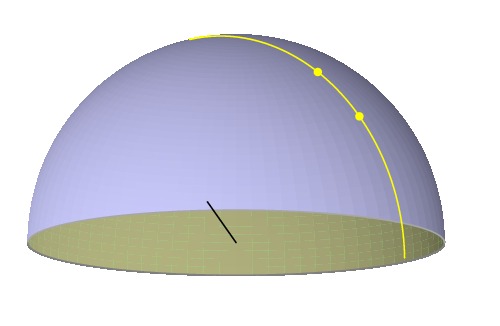 |
|
Since we would like our dial to record the time
accurately on every day of the year, the shadow cast
by the style should lie on the same line when it
is on this meridian.
|
 |
|
Notice that a plane is formed by the sun's
positions on this meridian and the center of the
style. Since we would like for the style's shadow
to fall in this plane, we require that the style
also lies in this plane.
|
 |
|
This property should hold at every time of day
and hence for every meridian. Therefore, the style
should be in the intersection of all such planes
implying that the style should be oriented so
that it is parallel to the earth's axis. In
this orientation, the angle between the style and
the table should equal the latitude of the dial's
location.
|
 |
Marking hour lines on the table
|
Now that we know how the style is oriented, we
would like to understand how the lines should be
marked on the table to indicate the hours of the
day. We will use one particular line as a reference:
the shadow cast by the sun when it is on the noon
meridian. The convenience of this meridian comes
from the fact that it intersects the horizon perpendicularly.
|
 |
|
At another time of day, the sun will be located
on another meridian, and we would like to determine
the angle between the shadow cast by the style at
this time and that cast at noon.
|
 |
|
To determine the relationship between the time
and the angular distance between the hour lines,
construct this figure by extending tangent lines
to the celestial sphere at the end of the polar axis.
These lines will intersect the plane of the horizon
to form a pyramid.
|
 |
|
We are interested in the following angles. The
blue angle $s$ describes the angle between the two
hour lines; it is this angle that we seek. Since
the style is oriented along the polar axis, the red
angle is the latitude $\phi$. The green angle $h$
measures the angular difference between the current
meridian and noon meridian, which depends on the
current time.
|
 |
|
We will let $C$ be the center of the dial, $S$
the end of the style, $M$ the point where the tangent
to the noon meridian intersects the horizon, and
$H$ the point where the tangent to the current meridian
intersects the horizon.
|
 |
|
Since the noon meridian intersects the horizon
perpendicularly, we know that $\angle CMH$ and $\angle
SMH$ are right angles. Also, $SM$ is tangent to the
celestial sphere and $SC$ is a radius of that sphere
so $\angle CSM$ is also right.
|
 |
We may now apply simple trigonometry: $$ \begin{array}{rcl}
\cot s & = & CM/HM \\ \sin \phi & = & SM/CM
\\ \tan h & = & HM/SM. \end{array} $$
If we multiply these three expressions together, we obtain
$$ \begin{array}{rc} & \cot s \sin\phi \tan h = 1 \\
\mbox{or} & \qquad \tan s = \sin\phi\tan h. \end{array}
$$
Let's see this expression in action. I am writing this
column at a latitude of $\phi = 42.98^\circ$ N. Where will
the shadow fall on a horizontal dial two hours before my
solar noon? This time corresponds to $h=30^\circ$ so we have
$$ s = \arctan(\sin\phi\tan h) = \arctan(\sin(42.98^\circ)\cdot\tan(30^\circ))
= 21.5^\circ. $$
Therefore, we now know where to draw the hour line on which
the style's shadow will fall two hours before (or after)
solar noon.
Here is how a horizontal dial located at latitude $\phi
= 42.98^\circ N$ would appear, assuming that the sun is on
the noon meridian precisely at legal noon.

For most locations, of course, the sun is not on the noon
meridian precisely at legal noon. For instance, my longitude
is $85.96^\circ$ W, and my clock is set to Eastern time.
Therefore, at my location, the sun lags behind the clock
by $85.96 - 75 = 10.96$ degrees. This correction may be incorporated
into the formula above resulting in the following dial at
my location.

Tracing the sun's path
Now that we may use the sun's position to determine
the time of day, let's go a little further and use the
sun's position to determine the day of the year as well.
Here we assume that, on a given day, the sun appears to
move in a circle around the earth's rotational axis;
that is, we ignore the effect of the earth's motion along
its orbit in one day. In this figure, two of the sun's
daily orbits are shown. One orbit is in late winter or early
fall while the other is in early spring or late summer.
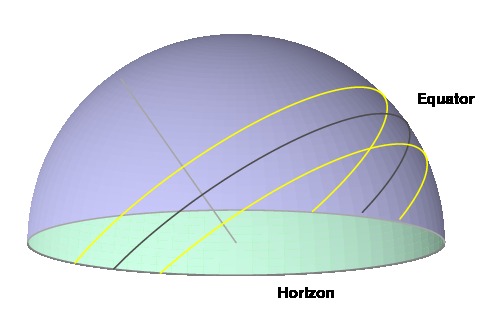
We would like to determine the path traced out by the style's
shadow as the sun moves through this orbit. Before we do
this, consider all the rays from the sun that pass through
the tip of the style; these will form a cone.

The style's shadow will lie on the intersection of
the dial's table with this cone. Remember now that the
intersection of a plane with a cone defines a conic section,
either a circle, ellipse, parabola or hyperbola depending
on the angle at which the plane intersects the cone:
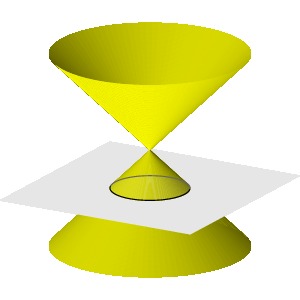 |
 |
| Circle |
Ellipse |
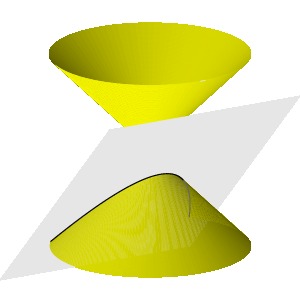 |
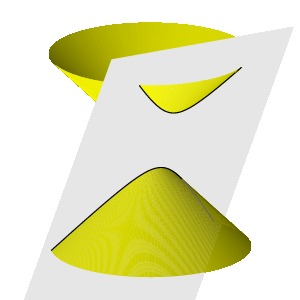 |
| Parabola |
Hyperbola |
A little thought shows that the sun's shadow on a horizontal
dial at one of the poles will trace out a circle on a summer's
day, while an elliptical shadow will be seen at slightly
lower latitudes. If we live in the temperate zone, we will
see hyperbolic shadows. Here is the shadow cast on a horizontal
dial on a typical day in the temperate zone.
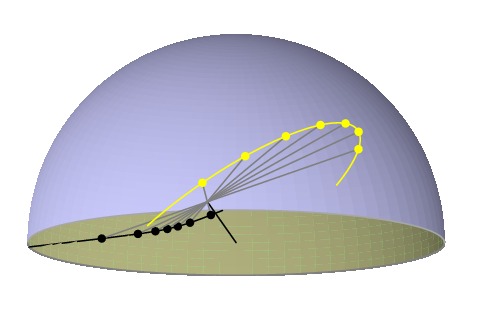
Knowing how the sun's declination varies over the year,
we may trace out the sun's path on several days of the
year.

The analemma
Up to this point, we have set up our dial using the mean
sun; that is, we have assumed that the sun is moving at a
constant angular velocity around the earth, which we know
is not true. The error in this assumption is seen if we photograph
the sun at noon, as measured by mean time, every day for
a year. If mean time and solar time agreed, we would see
the sun on the noon meridian every day with a varying declination.
However, solar time alternately leads and lags mean time,
which creates a figure eight curve called the analemma.

The analemma reflects the equation of time, which measures
the difference between mean and solar time and which we saw
earlier.

For instance, on a day on which the equation of time is
positive, mean time lags behind solar time. Therefore, at
mean time's noon, the sun will be west of the noon meridian.
We can use this to correct our dial by tracing out the analemma's
shadow on each of the hour lines.

Therefore, to read mean time from this sundial, we compare
the style's shadow to the images of the analemma rather
than the hour lines.
Summary
Sundials exist in an almost infinite variety of forms,
reflecting their use and the creative instincts of their
designers. I have aimed here to explain the design of a dial
constructed by Father Ildéphonse at the convent of
Cimiez-sur-Nice, which is reproduced in Rohr's book cited
in the References section. This design is also reflected
in the logo of the North
American Sundial Society. Using principles explained
in this article, it should be possible to explain most sundials
that you are likely to encounter.
References
- René R.J. Rohr, Sundials: History,
Theory, and Practice, Dover, New York, 1966.
As its title says, this delightful book covers all aspects
of sundials. Of particular note is the large collection
of photographs of interesting sundials.
- Lancelot Hogben , Mathematics for the Million,
W.W. Norton & Company, New York, 1993.
Hogben uses spherical trigonometry to explain how to place
the hour lines on a horizontal dial. The illustrations
are particularly nice.
There are a large number of sundial related links on the
Internet, including these:
Here are some general references about time and time keeping:



 David Austin
David Austin 































